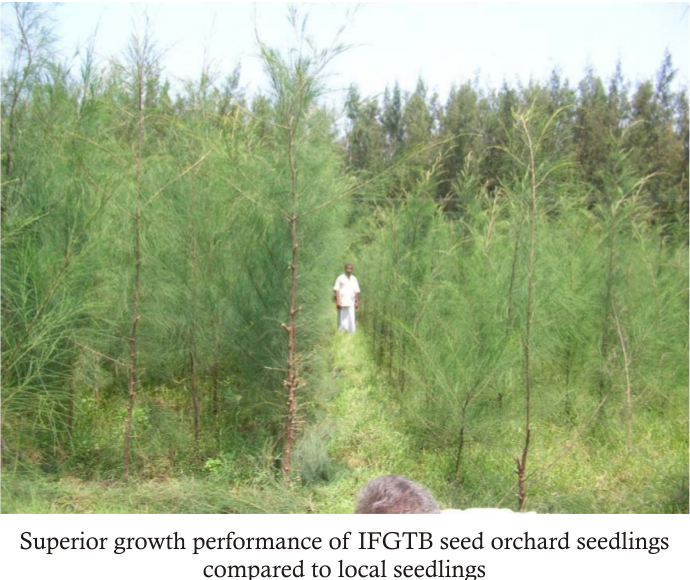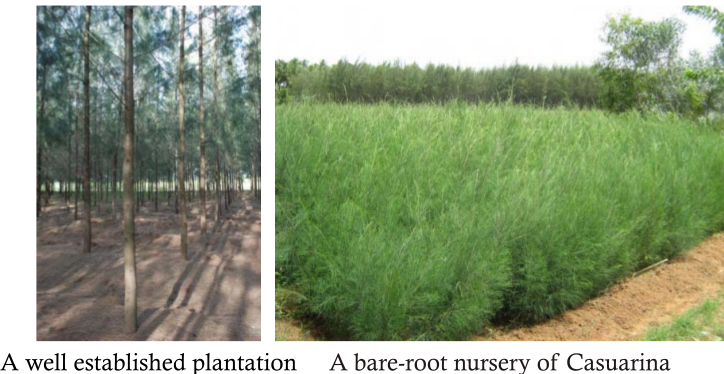Casuarina
Casuarina
Introduction
Casuarinas are a versatile group of plants with wide-ranging adaptability to grow in different environments and provide multiple end uses and services. They fix atmospheric nitrogen through a symbiotic association with the bacteria, Frankia. Casuarina wood with a high calorific value is a renowned fuel wood in the tropics. In India Casuarina equisetifolia was introduced during the 19th century and is now estimated to be under cultivation in around half a million hectares mainly in the Peninsular region. Apart from fuel, the wood is extensively used for papermaking and of late is a preferred choice for biomass-based power generation. The straight cylindrical stems find use in rural house building and as scaffolds in construction sites. It is the principal species for developing shelterbelts in coastal areas and windbreaks for protecting agricultural crops. It also plays a key role in reclaiming mined areas and afforesting nutrient-poor sites.
Nursery
Casuarina seeds are small consisting 5 to 6 lakh seeds per kg. But about half of them may actually be immature seeds which usually do not germinate. Germination is generally around 30% and about 30,000 to 100,000 seedlings are obtained from a kg of seed depending upon source of seed and nursery efficiency. Seeds are sown in raised sand beds (called ‘mother beds’) of the size 10 x 1 m. Generally no pretreatment is necessary for casuarina seeds. In each bed about 250 g of seeds (50 g for Casuarina junghuhniana) are evenly spread by mixing with fine sand. They are overlaid with a thin layer of sand. The sand bed is covered with rice straw to prevent washing off of seedlings while watering. Water is provided through a rose can or a sprayer. A suitable repellent is applied along the periphery of the bed to prevent ants removing the seeds.
Germination and transplanting
Seeds start germinating from the 5th day and the straw is removed on the 7th day. They are grown in the mother beds for the next 3 to 4 weeks. After 4 weeks when the seedlings attain 8 – 10 cm height they are transferred either to a secondary bed or polythene bags. Secondary beds are also of the same size as the mother beds but in addition to sand, farm manure and soil (2:1:1) are also added to increase nutrient availability and water holding capacity. Seedlings pricked from the primary beds are transplanted in the secondary bed at approximately 4 cm apart. Seedlings are grown in the secondary beds for 3 months to obtain a height of 30 to 45 cm and a collar diameter of 3 to 5 mm. Growing seedlings in polybags and root trainers is better than bare root seedlings especially for planting in rainfed areas. Seedlings raised in containers establish well in plantations and record vigorous growth in the first year. Polybags (size: 15 x 7 cm) filled with a potting mixture of sand, farm manure and soil in a ratio of 2:1:1 are suitable for raising casuarina seedlings. Seedlings may attain plantable size within 2 months but can be maintained for another 4 to 6 months if planting is delayed.
Vegetative propagation
Outstanding casuarina trees can be propagated by rooting of young shoots (‘sprigs’). Such plants produce uniform superior growth in plantations. Sprigs collected from selected trees are trimmed to 8-10 cm long and washed in a 5% solution of fungicide like Bavistin. The lower portion of the shoot is treated with a rooting hormone, Indole butyric acid. The treated cuttings are placed in root trainers containing vermiculite or treated coir pith and kept in mist chamber or propagation chambers made of polythene sheets. Rooting occurs in 15 to 20 days and then transplanted into polybags or root trainers and grown in the same way as seedlings.
Inoculation of Frankia
Casuarina is a nitrogen-fixing tree through symbiotic relationship with an actinomycete called Frankia. It fixes atmospheric nitrogen in special structures in the roots called nodules. It is necessary to ensure infection of Frankia in casuarina seedlings for vigorous growth as well as to increase their adaptability to planting conditions. Frankia can easily be inoculated by adding topsoil from casuarina plantations to the mother beds. Alternatively it can be inoculated at the time of transplanting into secondary beds or containers by treating the seedlings with nodule extract of Frankia culture (N-fixer). Application of biofertilizers like phosphobacterium and Glomus fasciculatum also improve the seedling quality.
Planting and Tending Methods
Since casuarina is planted as bare-root seedlings, planting them just before or during the rains ensures high survival especially under rainfed conditions. Where irrigation is available, it is recommended to plant one month before the rain and provide water once or twice a week. This will help the plants to establish well before the arrival of monsoon and grow faster than those planted during the rain.
Land must be preferably disc ploughed twice. Pit size for planting container-raised plants (poly bag or root trainer) is 30 cm x 30 cm x 30 cm. The recommended spacing for realizing full potential of genetically improved planting stock is 1.5 x 1.5 m. Add a basal dose of 10 g of super phosphate per pit before field planting of seedlings. Application of anti-termite solution (e.g. chlorophyriphos 1ml per litre of water) may be needed in red soils or where the problem has been encountered before. This may not be necessary in sandy soils in coastal areas. If no rain received immediately after field planting of seedlings, watering in alternate days is necessary for the first two weeks. The frequency may be reduced gradually to once or twice a week depending upon local conditions. Casualty replacement should be taken up only up to one month after planting. Four weedings needs to be carried out at 3, 6, 9 and 12 months or till the canopy closes whichever is later. Two prunings need to be taken up at 12 and 24 months. Fertilizer application is not necessary after planting if the land is fairly fertile. In low-nutrient soils DAP 100 kg per acre may be applied between 12 and 24 months.
Fertilizer Application
Fertilizer application is generally restricted to irrigated plantations and varies between regions and even among farmers. Fertilizers will have the maximum effect if applied during the peak growing period of 12 to 24 months. Farmers generally apply 50 kg of urea and 50 to 100 kg of DAP per acre one year after planting. Casuarina does not need large quantity of nitrogen fertilizer since it produces its own nitrogen with the help of the bacterium, Frankia. So it is recommended to apply 11 kg of urea and 94 kg of super phosphate at four stages: immediately after establishment, 6, 12 and 18 months after planting.
Pruning and intercropping
Pruning of side branches is usually carried out between first and second years and second and third years. The expenditure for pruning is met by the sale of pruned material. It is also a common practice to intercrop groundnut, water melon or pulse crops in the first year well before the tree crown starts closing in and cause shade effect to agriculture crop. The plantation establishment cost is generally recovered from the agriculture crop. It also helps to keep the field weed-free.
Insect and disease incidence
Casuarina has only a few major insect and disease incidence which can lead to economic loss. The common insect problem in casuarina plantation is attack by the stem borer, Indarbela quadrinotata. The larvae dig up deep tunnels on the main stem and remain inside the tunnel during day time and emerge out in night and feed on the bark. Although the trees generally survive, the pole quality is affected by severe infection. Affected trees are also prone to breaking at the point of infestation during heavy wind. Chemical control of this insect is difficult since it resides within the tunnel. Insect attack can be prevented by planting varieties that are unaffected by the insect (e.g. Australia and Kenya).
Wilt or blister bark disease caused by Trichosporium vesciculosum results in drying up of trees followed by large scale death. Affected trees show symptoms of drying of leaves followed by ‘blisters” on the main stem. At advanced stages these blisters burst open releasing black spores. The disease is not considered as a serious problem in plantations because it usually occurs in plantations older than 4 years age. There is no effective control measure once the infection occurred but removing and burning the infected tree can prevent further spreading of the disease. Australian, Kenyan and Malaysian provenances were found to be resistant to blister bark disease. The C. junghuhniana provenances from East Timor are also not affected by the disease.
Rotation Period and Yield
The commonly followed rotation period is 4 years with irrigation and 6 years under rainfed conditions. But the duration varies greatly in different areas and between farmers. In a few places of coastal Tamil Nadu irrigated casuarina is harvested as early as 2.5 years of age.


Whereas Forest Department plantations without irrigation are retained up to 8 years. Wood production varies greatly across locations, cultivation techniques adopted and age at which harvested. Plantations with irrigation and fertilizer application yield 100 to 150 tonnes of air dried wood (up to 20 cm girth) per hectare (40 to 60 tonnes per acre) in 4 years. Under rainfed conditions an average yield of 75 to 100 tonnes per hectare is obtained in 6 years (30 to 40 tonnes per acre) depending upon soil quality and amount of rainfall during the cultivation period. IFGTB supplies high quality seeds from seed orchards which can improve yield up to 25% and the superior clones (IFGTB CE 1, CE2, CE3, CE4, CJ9 and CJ10) produce up to 50% more yield.
Source: Transfer of Tree Cultivation Technologies to Krishi Vigyan Kendras - Publication by Institute of Forest Genetics and Tree Breeding,Coimbatore.
Last Modified : 3/1/2020
This topic deals with information related to Anxie...
This topic deals with information related to Appen...
The Article provides information about Antioxidant...
This topic provides information about Sim Card Swa...
